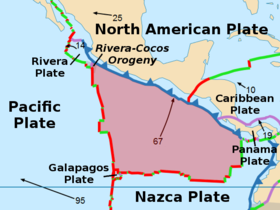| Cocos plate | |
|---|---|
 | |
| Type | Minor |
| Approximate area | 2,900,000 km2[1] |
| Movement1 | north-east |
| Speed1 | 67 mm/year |
| Features | Cocos Island, Pacific Ocean |
| 1Relative to the African plate | |
The Cocos plate is a young oceanic tectonic plate beneath the Pacific Ocean off the west coast of Central America, named for Cocos Island, which rides upon it. The Cocos plate was created approximately 23 million years ago when the Farallon plate broke into two pieces, which also created the Nazca plate. The Cocos plate also broke into two pieces, creating the small Rivera plate.[2] The Cocos plate is bounded to the northeast by the North American plate and the Caribbean plate. To the west it is bounded by the Pacific plate and to the south by the Nazca plate.
The only land above water on the Cocos plate is Cocos Island, which is administered by Costa Rica and lies approximately 550 km (342 mi; 297 nmi) southwest of the Costa Rican mainland.
- ^ "Here are the Sizes of Tectonic or Lithospheric Plates". Archived from the original on 2007-02-09. Retrieved 2015-05-05.
- ^ Manea, V.C.; Manea, M.; Ferarri, L. (2013). "A geodynamical perspective on the subduction of Cocos and Rivera plates beneath Mexico and Central America" (PDF). Tectonophysics. 609: 56–81. Bibcode:2013Tectp.609...56M. doi:10.1016/j.tecto.2012.12.039. Retrieved 24 April 2017.[permanent dead link]